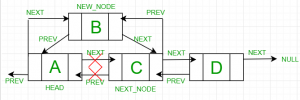正在载入交互式动画窗口请稍等
双链表-带头结点 可视化交互式动画版

在双向链表中插入新节点与在链表中插入新节点非常相似。 维护前一个节点的链接需要一些额外的工作。 可以通过四种方式将节点插入双向链表:
- 在DLL的前面。
-
在两个节点之间
- 在给定节点之后。
- 在给定节点之前。
- 在 DLL 的末尾。
在双向链表的前面添加一个节点:
新节点始终添加到给定链表的头之前。 该任务可以通过以下 5 个步骤来执行:
- 首先,分配一个新节点(例如 new_node )。
- 现在将所需的数据放入新节点中。
- 使new_node 的next 指向双向链表的当前头。
- 使当前头的前一个指向 new_node 。
- 最后,将 head 指向 new_node 。
插图:
请参见下图,其中 E 被插入到双向链表的开头。

下面是在链表前面插入节点的5个步骤的实现:
- C
- C++
- Java
- Python3
- C#
- JavaScript
C
// Given a reference (pointer to pointer) to the head// of a list and an int, inserts a new node// on the front of the list.void push(struct Node** head_ref, int new_data){ // 1. allocate node struct Node* new_node = (struct Node*)malloc(sizeof(struct Node)); // 2. put in the data new_node->data = new_data; // 3. Make next of new node as head and previous as NULL new_node->next = (*head_ref); new_node->prev = NULL; // 4. change prev of head node to new node if ((*head_ref) != NULL) (*head_ref)->prev = new_node; // 5. move the head to point to the new node (*head_ref) = new_node;} |
C++
Java
Python3
C#
Javascript
时间复杂度:
O(1)
辅助空间:
O(1)
在两个节点之间添加一个节点:
又分为以下两部分:
在双向链表中的给定节点之后添加一个节点:
我们将获得一个指向节点的指针 prev_node ,并且新节点将插入到给定节点之后。 这可以通过以下 6 个步骤来完成:
- 首先创建一个新节点(例如 new_node )。
- 现在将数据插入新节点。
- 将new_node 的下一个指向 prev_node 的下一个 。
- 将prev_node 的下一个 指向 new_node 。
- 将new_node 的前一个 指向 prev_node 。
- 将新节点的前一个指针更改为 new_node 。
插图:
请参见下图,其中“ E ”被插入到“ B ”之后。

下面是在链表中给定节点之后插入节点的 7 个步骤的实现:
- C
- C++
- Java
- Python3
- C#
- JavaScript
C
// Given a node as prev_node, insert a new node // after the given node
void insertAfter(struct Node* prev_node, int new_data){ // Check if the given prev_node is NULL if (prev_node == NULL) { printf("the given previous node cannot be NULL"); return; } // 1. allocate new node struct Node* new_node = (struct Node*)malloc(sizeof(struct Node)); // 2. put in the data new_node->data = new_data; // 3. Make next of new node as next of prev_node new_node->next = prev_node->next; // 4. Make the next of prev_node as new_node prev_node->next = new_node; // 5. Make prev_node as previous of new_node new_node->prev = prev_node; // 6. Change previous of new_node's next node if (new_node->next != NULL)
new_node->next->prev = new_node;} |
C++
Java
Python3
C#
Javascript
时间复杂度:
O(1)
辅助空间:
O(1)
在双向链表中的给定节点之前添加一个节点:
令指向该给定节点的指针为 next_node 。 这可以通过以下 6 个步骤来完成。
- 为新节点分配内存,命名为 new_node 。
- 将数据放入 new_node 中。
- 将这个new_node 的前一个指针设置为 next_node 的前一个节点 。
- 将next_node 的前一个指针设置 为 new_node 。
- 将这个new_node 的下一个指针设置 为 next_node 。
-
现在设置new_node
的前一个指针
。
- 如果 new_node 的前一个节点不为 NULL,则将该前一个节点的下一个指针设置为 new_node 。
- 否则,如果 new_node 的 prev 为 NULL,则它将成为新的头节点。
插图:
请参见下图,其中“ B ”被插入到“ C ”之前。

下面是上述方法的实现。
- C
- C++
- Java
- Python3
- C#
- JavaScript
C
// Given a node as prev_node, insert a new node // after the given node
void insertBefore(struct Node* next_node, int new_data){ // Check if the given next_node is NULL if (next_node == NULL) { printf("the given next node cannot be NULL");
return; } // 1. Allocate new node struct Node* new_node = (struct Node*)malloc(sizeof(struct Node)); // 2. Put in the data new_node->data = new_data; // 3. Make previous of new node as previous of next_node new_node->prev = next_node->prev; // 4. Make the previous of next_node as new_node next_node->prev = new_node; // 5. Make next_node as next of new_node new_node->next = next_node; // 6. Change next of new_node's previous node if (new_node->prev != NULL)
new_node->prev->next = new_node; else head = new_node;} |
C++
Java
Python3
C#
Javascript
时间复杂度:
O(1)
辅助空间:
O(1)
在双向链表的末尾添加一个节点:
新节点始终添加在给定链表的最后一个节点之后。 这可以通过以下 7 个步骤来完成:
- 创建一个新节点(例如 new_node )。
- 将值放入新节点。
- 将new_node 的next指针设置 为null。
- 如果链表为空,则将 new_node 作为头。
- 否则,移动到链表的末尾。
- 现在使最后一个节点的下一个指针指向 new_node 。
- 将new_node 的前一个指针更改 为链表的最后一个节点。
插图:
请参见下图,其中“ D ”被插入到链表的末尾。

下面是在链表末尾插入节点的7个步骤的实现:
- C
- C++
- Java
- Python3
- C#
- JavaScript
C
// Given a reference (pointer to pointer) to the head// of a DLL and an int, appends a new node at the endvoid append(struct Node** head_ref, int new_data){ // 1. allocate node struct Node* new_node = (struct Node*)malloc(sizeof(struct Node)); struct Node* last = *head_ref; /* used in step 5*/ // 2. put in the data new_node->data = new_data; // 3. This new node is going to be the last node, so // make next of it as NULL new_node->next = NULL; // 4. If the Linked List is empty, then make the new // node as head if (*head_ref == NULL) { new_node->prev = NULL; *head_ref = new_node; return; } // 5. Else traverse till the last node while (last->next != NULL) last = last->next; // 6. Change the next of last node last->next = new_node; // 7. Make last node as previous of new node new_node->prev = last; return;} |
C++
Java
Python3
C#
Javascript
时间复杂度:
O(n)
辅助空间:
O(1)